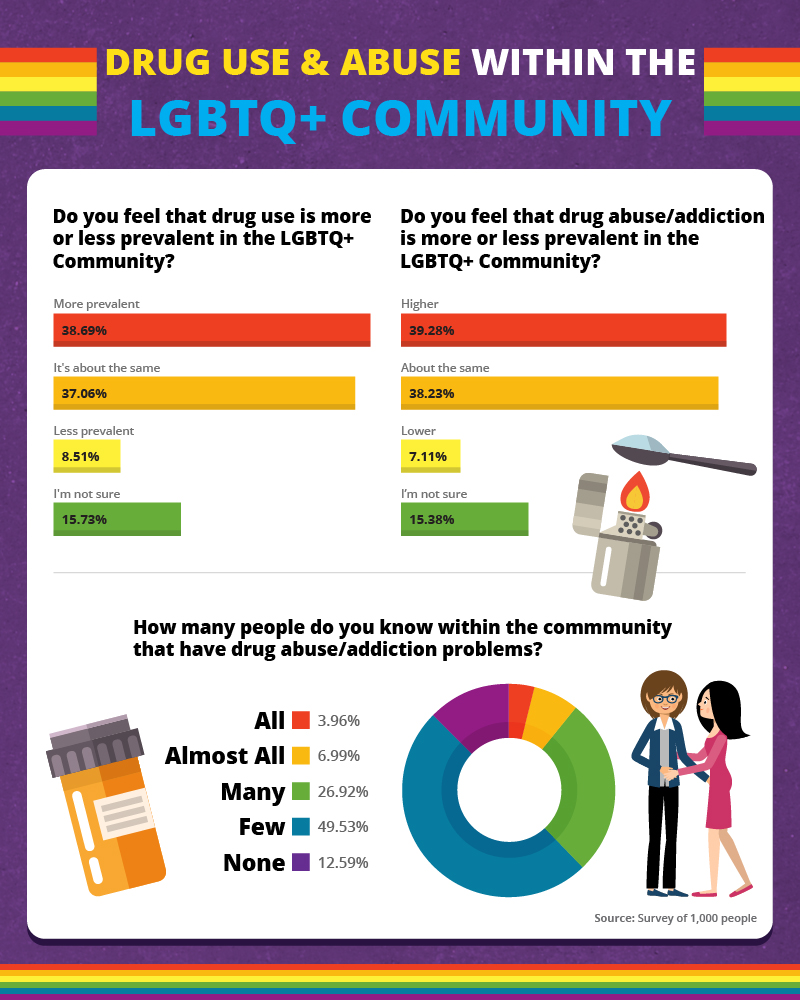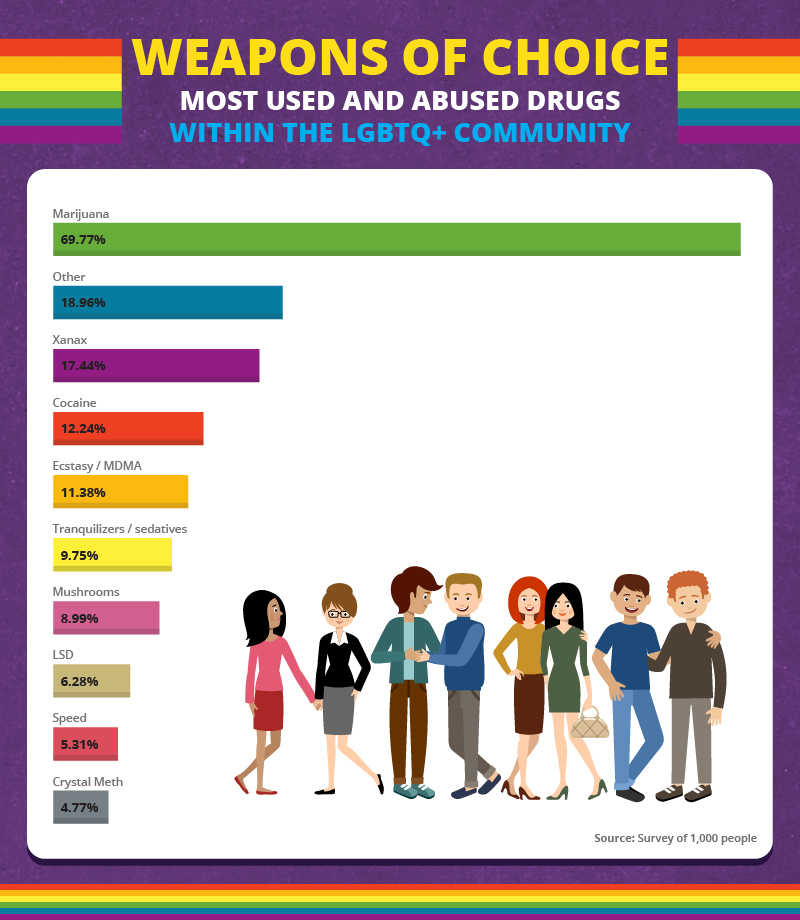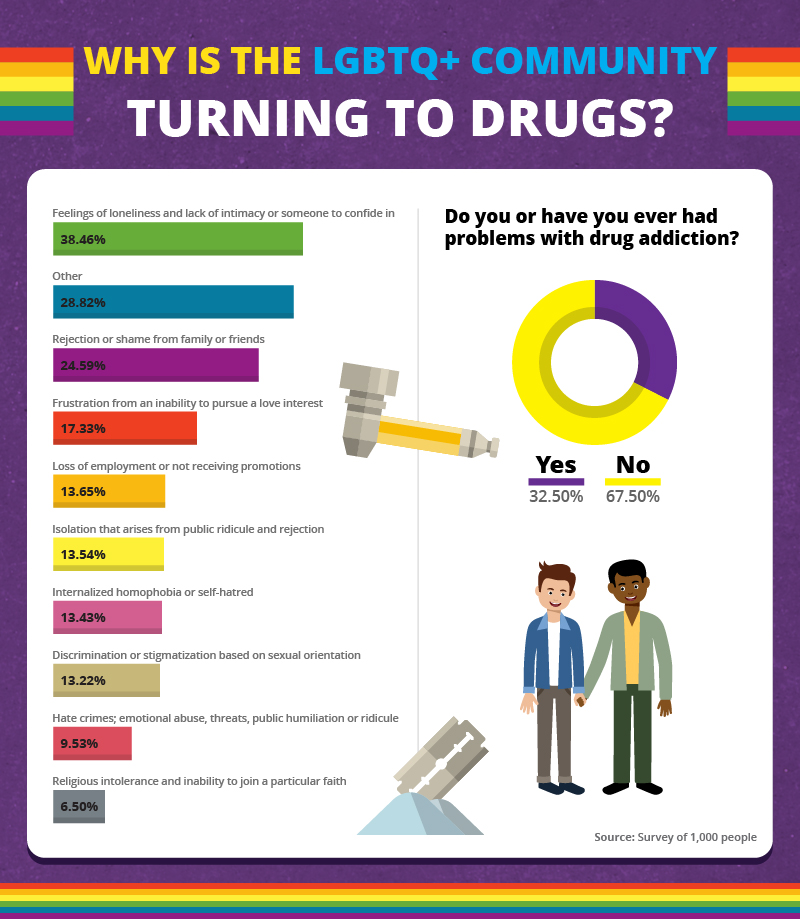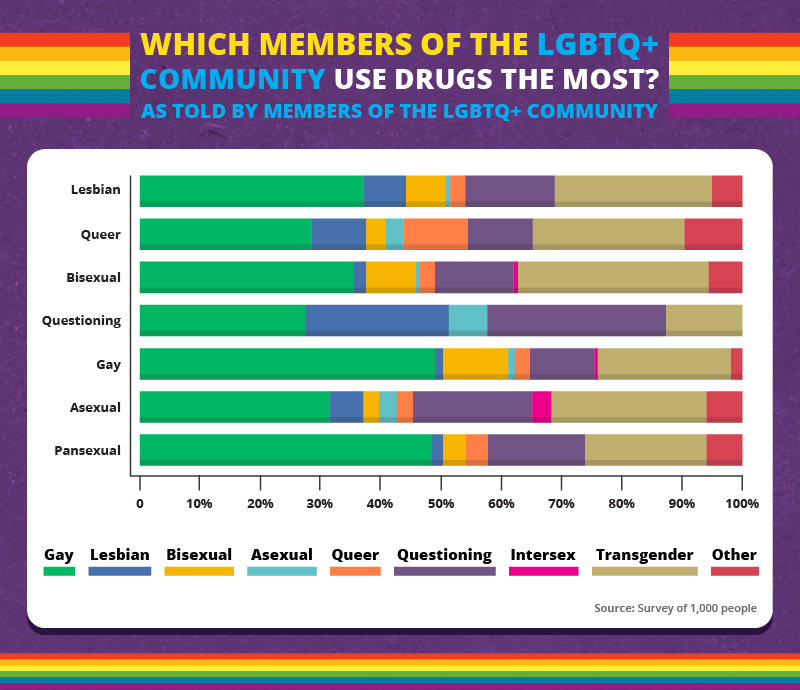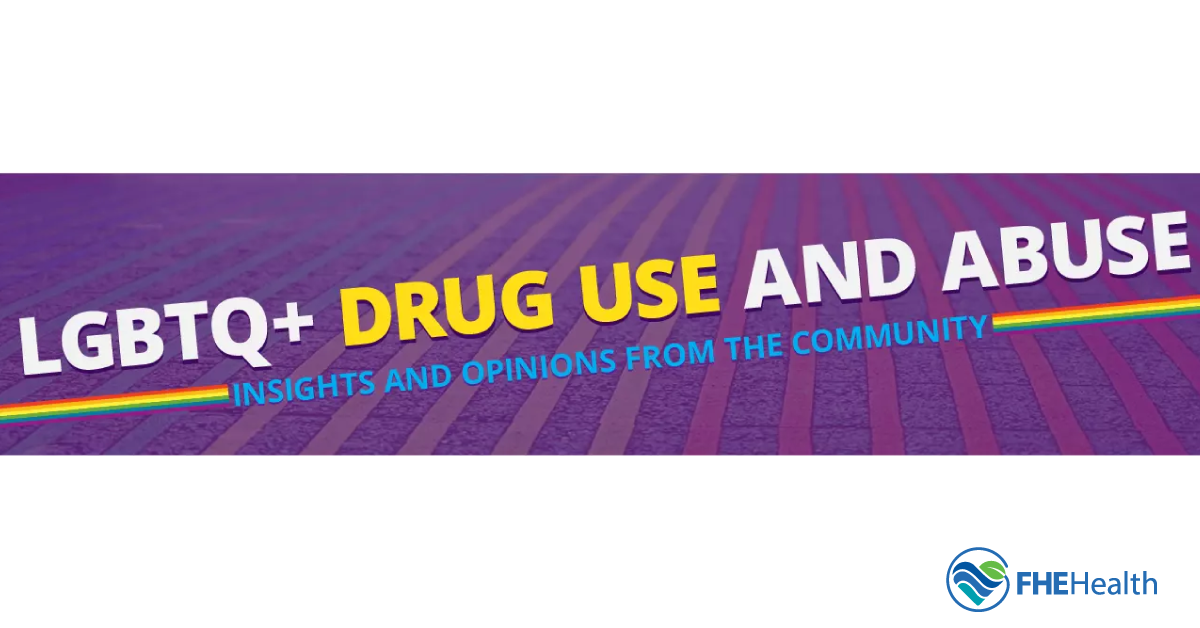
Life isn’t always easy for members of the LGBTQ+ community (people who identify as lesbian, gay, bisexual, transgender, queer/questioning, or other orientations). According to a recent report for National Public Radio, the Robert Wood Johnson Foundation, and Harvard T.H. Chan School of Public Health, the majority of LGBTQ+ individuals have dealt with sexual assault, violence, or threats, which could lead to increased drug use in the LGBTQ+ community. Many also face high-stress levels, lack support systems, and encounter family rejection.
For many in the community, these challenges can increase the risk of mental health disorders as well as drug abuse in the LGBTQ+ community as a coping mechanism. We surveyed over 1,000 members of the community in order to explore their experiences with mental health issues and drug use. We looked at common mental health disorders, popular types of illicit drugs, which community members seem to be most at risk for addiction, and what reasons people cite for turning to drugs. Read on for exclusive insights from members of the LGBTQ+ community.
Mental Health Disorders Among LGBTQ+ People
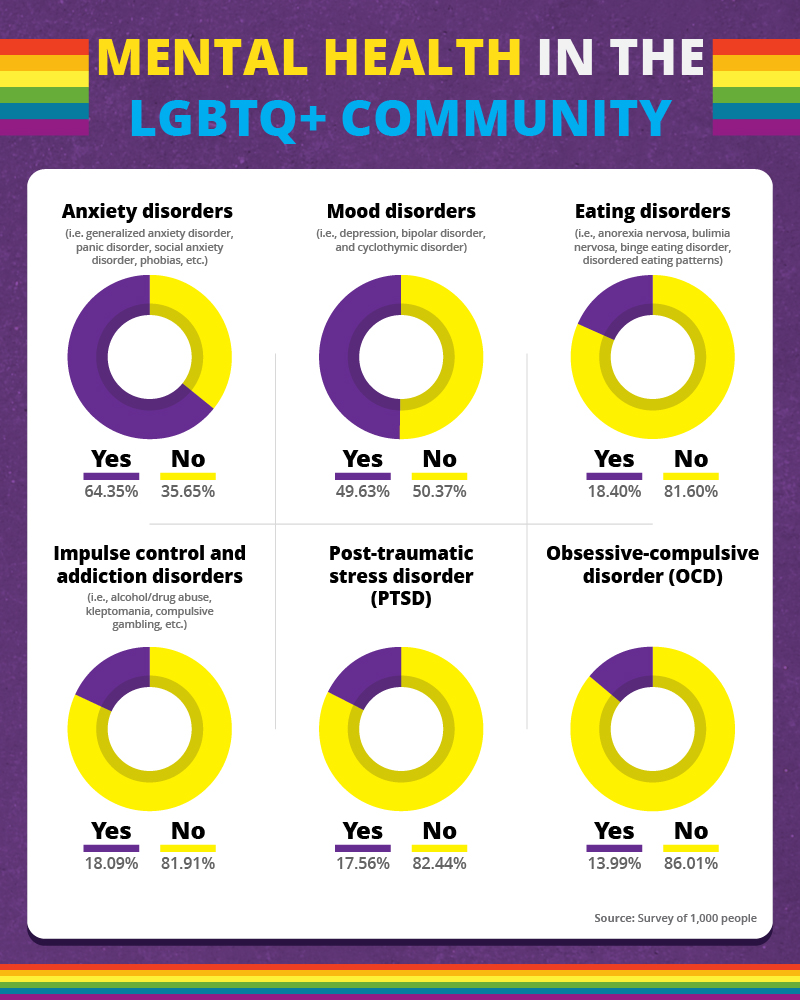
According to the National Alliance on Mental Illness (NAMI), members of the LGBTQ+ community are nearly three times more likely to experience mental health conditions than the average person. This can generally be attributed to a number of challenges some LGBTQ+ people might face, including discrimination, prejudice, harassment, denial of common rights, and rejection from family.
Nearly 65 percent of our respondents from the LGBTQ+ community report they have experienced some sort of anxiety disorder, such as generalized anxiety disorder, panic disorder, social anxiety disorder, or some type of phobia. In addition, more than half report that they’ve dealt with some type of mood disorder, such as depression, bipolar disorder, or cyclothymic disorder (a mood disorder characterized by highs and lows).
Around 18 percent have experienced an eating disorder, and 18 percent report dealing with impulse control and addiction disorder. Just slightly fewer report having post-traumatic stress disorder (PTSD), and nearly 14 percent have experienced obsessive-compulsive disorder (OCD).
Substance Abuse in the LGBTQ+ Community
According to NAMI, approximately 9 percent of people in the general population abuse illicit drugs—compared with a staggering 20 percent to 30 percent of LGBTQ+ people. To explore the reasons for this large discrepancy, we asked our respondents to share their first-hand knowledge about the use and abuse of drugs among the LGBTQ+ community.
When asked if they believe drug use and drug abuse in the LGBTQ+ community is more prevalent, around 39 percent said yes, and another 37 percent said they believe it’s about the same. Around 9 percent report, it’s less prevalent, while 16 percent are uncertain. The responses about drug abuse and addiction were similar: Around 39 percent believe abuse/addiction is more prevalent in the LGBTQ+ community, around 38 percent report it’s the same, 7 percent say it’s less prevalent, and 15 percent are uncertain. If you or someone you know is suffering from drug addiction, consider in house rehabilitation at a detox treatment center in Florida.
How many fellow LGBTQ+ community members struggling with drug abuse or addiction do our survey participants know? Nearly half of respondents report they know a few people struggling with drug abuse, and another 27 percent say they know many people experiencing addiction. Nearly 13 percent say they don’t know any LGBTQ+ community members who abuse drugs.
Which Illicit Drugs Are Most Popular for LGBTQ+ People?
Around 7 in 10 of our respondents report they use (or used) marijuana on a regular basis (once a week or more). Just over 17 percent report Xanax is their drug of choice (bisexual rapper Lil Peep recently died of a Xanax overdose), while 12 percent use(d) cocaine, and 11 percent use(d) MDMA/ecstasy. Tranquilizers, mushrooms, and LSD also made the list. Around 19 percent reported using “other” substances.
In some LGBTQ+ circles, the “party and play” culture means rampant use of club and party drugs. Chemsex, which refers to men taking drugs (particularly crystal meth) during sex, has become a dangerous issue. To help combat the issue of chemsex, Grindr recently banned some words from its chat app.
Reasons LGBTQ+ People Might Use Illicit Substances
Nearly 68 percent of our respondents report they have struggled with drug addiction at some point, which may lead to an increase in drug rehab in the community. The reasons they cite for turning to illicit substances are varied. For almost 39 percent, feelings of loneliness and a lack of intimacy or a confidant drove them to abuse drugs. One-quarter of respondents report rejection or shame from family and friends was the reason, while another 17 percent cite frustration with the inability to openly pursue a relationship. Isolation, internalized homophobia, and employment loss were also among the reasons.
Problems can begin early for members of the LGBTQ+ community. According to a report by the Human Rights Campaign Foundation, “minority stress” is a serious problem among LGBTQ youth. Teens in the LGBTQ community are twice as likely as non-LGBTQ teens to be physically assaulted, verbally harassed, or excluded at school. They are also more likely to be abused as children and less likely to have trusted adults in their lives to turn to for support.
Drug Use Rates Among Specific LGBTQ+ Community Members
When asked which particular subset of the LGBTQ+ Community uses drugs most, the response of people who identified as gay dominated. Half of respondents, as well as 29 to 50 percent of participants who identify in any other way, reported community members have higher rates of substance abuse, which could impact drug rehab in the LGBTQ+ community. Transgender people were the second-most mentioned group for drug use (note that, as is common in surveys, there were not sufficient transgender respondents to break out the group’s data).
A few insights stand out: Between 10 percent and 19 percent of each group noted questioning people have a high rate of drug use, but a whopping 29 percent of questioning people pinpointed themselves. Questioning people also had a disproportionately high estimate of drug use for people who identified as lesbian. Asexual people ranked relatively low for perceived drug use—including among their own members.
It’s not easy to pinpoint specific reasons for these disparities, but it’s clear that some groups may endure greater challenges than others. Some research reveals that youth who are gender non-conforming are at greater risk for drug use in the LGBTQ+ community and abuse, possibly due to increased harassment and stigma. For instance, one study reveals that lesbians who identify as “butch” are more likely to use marijuana and alcohol. In addition, compared with other members of the LGBTQ+ community, transgender people more frequently encounter risk factors for substance abuse, such as victimization from their peers and psychological distress.
Suffering from Drug Use in the LGBTQ+ Community
As our survey revealed, members of the LGBTQ+ face unique challenges when it comes to mental health and drug use. However, there’s hope for drug recovery. Historically, members of this community have had difficult experiences obtaining high-quality mental health treatment.
While the situation has improved, it’s not always easy for LGBTQ+ people to find providers they trust when seeking help for mental health disorders and drug use. While there are more than 400 LGBTQ-friendly hospitals across the country, most of these do not specifically offer LGBTQ-friendly addiction programs. For people seeking treatment, it’s crucial to have a provider who is non-judgmental, trustworthy, and supportive. If you or someone you love is dealing with a mental health disorder or substance use issue, reach out to us at FHE Health, a South Florida LGBTQ-friendly addiction treatment facility and mental health facility, for the expert help you deserve. Consider a detox center in South Florida if you or any of your friends need assistance with helping an addict. FHE Health believes firmly in communication in substance abuse treatment and recovery.
Methodology
We surveyed 1,033 people who reported being a member of the LGBTQ+ community. Our respondents chose to participate in the survey and the only qualifier was that the people surveyed had to self-identify as members of the LGBTQ+ community for this study on drug use.
Sources
- https://www.news-medical.net/news/20171121/Survey-Majority-of-LGBTQ-people-experience-violence-threats-or-sexual-harassment.aspx
- https://www.nami.org/Find-Support/LGBTQ
- https://www.nbcnews.com/feature/nbc-out/death-bisexual-rapper-lil-peep-highlights-mental-health-disparities-n821861
- https://elpasoheraldpost.com/party-and-play-drug-culture/
- https://www.buzzfeed.com/patrickstrudwick/inside-the-dark-dangerous-world-of-chemsex?utm_term=.ko10og9R3#.ra0PAkx9N
- https://www.huffingtonpost.com/raina-bowe/lgbtq-drug-addiction-the-_b_7926076.html
Fair Use
Want to use our study? Please feel free! All that we ask is that you include a link back to this page so readers can learn more about the study.
